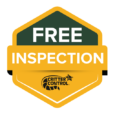Finding evidence of pests or nuisance wildlife is alarming. Pests and animals disrupt your life, damage your home, and introduce health risks to you and your family.
Nuisance wildlife like raccoons, squirrels, rats, mice, opossums, bats, and birds are some of the most common household pests. Typical signs of pests and nuisance wildlife include unusual noises, strange odors, damage to the exterior of buildings, and paw prints or tracks.
For over forty years, we have been trusted to solve nuisance wildlife infestations, restore and repair their property, and protect their home from future infestations.
Critter Control Wildlife Removal Process
Critter Control is here for you every step of the way in the wildlife removal process. We were instrumental in defining the humane process to get rid of pests and wildlife. Over four decades, we have refined the process to safely and humanely remove wildlife from people’s property. We have the services you need to get rid of raccoons, squirrels, bats, rodents, and other pests effectively and efficiently.
Wildlife Inspection
Our inspections cover the entire house. Based on what you have seen, heard and smelled, we start the inspection where you have noticed signs of animal activity. The inspection process identifies the target pests, the size of the infestation, and animal entry points.
Trapping and Removal
We develop a custom animal trapping and removal plan based on our whole home inspection. Humane wildlife strategies include animal traps, one-way doors, harassments techniques, pest repellents, and habitat modifications. Once we guarantee the animal is gone, we install exclusions for long-lasting pest control.
Exclusions and Repairs
Exclusion techniques repair animal entry holes and strengthen potential ones. Exclusions provide immediate animal and pest control to your home.
Pests and nuisance wildlife damage your home. Inside your home, animals build nests and dens. They will create runs through the insulation and gnaw on electrical wires and pipes. Animals can also spread diseases. We apply sanitation agents to clean up feces and urine. Mammals can host pests like fleas, ticks, and mites. Ectoparasite treatments exterminate those pests so you don’t become their next host.
Q&A with Critter Control of Irvine
What are some of the most common wildlife issues that homeowners face in your area? Raccoons often invade attics, crawlspaces, and chimneys, causing structural damage, leaving behind droppings, and spreading diseases like rabies and leptospirosis.
Roof rats and house mice are a major concern in Orange County and Long Beach, entering homes through small gaps and nesting in walls, attics, and basements. They chew on wires (creating fire hazards) and contaminate food.
Coyotes are increasingly entering residential areas, posing a threat to pets and sometimes humans. They are drawn to pet food, garbage, and unsecured yards.
Squirrels frequently invade attics, chew through insulation and wiring, and create fire hazards. They also nest in trees close to homes, increasing the risk of entry.
Skunks dig under decks, porches, and sheds, causing property damage. They spray a foul-smelling odor when threatened and can carry rabies.
Birds and bats roosting in vents, attics, or eaves can spread diseases like histoplasmosis and cause unsanitary conditions.
Opossums scavenge in trash, create messes, and carry parasites like fleas and ticks that can spread to pets.
How do the seasons affect wildlife activity in your area? Wildlife activity in Orange County, Irvine, and Long Beach shifts with the seasons, bringing different challenges year-round. In spring, animals like raccoons, squirrels, and rodents invade attics and crawlspaces to nest. Summer sees increased coyote sightings as they search for food, while skunks and rodents become more active around homes. As fall arrives, wildlife seeks shelter indoors—rodents, raccoons, and bats often find their way into attics and walls. By winter, infestations peak, with rodents multiplying rapidly and larger animals like raccoons and skunks taking refuge in warmer spaces.
What are some common signs of nuisance wildlife activity? Recognizing the early signs of nuisance wildlife activity can prevent costly damage and health risks. Unusual noises like scratching, scurrying, or thumping in attics and walls often indicate rodents, raccoons, or squirrels. Droppings and strong odors around your home, especially in basements or near vents, suggest an active infestation. Chewed wires, insulation damage, or gnawed entry points are common with rats and squirrels, while tipped-over trash cans and scattered debris point to raccoons or opossums. Burrows under decks or sheds signal skunks, and if you notice damaged vents or nests in chimneys, birds or bats may have moved in.
Any prevention or exclusion tips for residents in your area?
Seal all entry points around your property, including gaps in windows, doors, and attic vents, as even small openings can invite rodents, raccoons, and squirrels inside.
Keep your garbage securely contained and avoid leaving pet food outside to reduce attractants for raccoons and skunks.
Trim back tree branches that provide easy access to roofs or chimneys for raccoons and squirrels.
Install mesh or netting around vents, chimneys, and other potential entry spots to keep birds and bats out.
If you have a crawl space or basement, make sure to seal it tightly to prevent larger animals like opossums and skunks from seeking shelter. By taking these steps, you’ll significantly reduce your chances of a wildlife problem.
When should homeowners call you? Homeowners should call us as soon as they notice any signs of nuisance wildlife activity, such as scratching or scurrying sounds in attics, visible droppings, or chewed wires. If you spot animals near your home or notice damage to your property, it’s essential to act quickly before the situation worsens. Waiting can lead to more severe infestations, costly repairs, and health risks.
This franchise is independently licensed and operated by Crit Con, LLC, dba Critter Control of Irvine, CA


